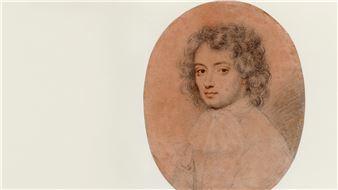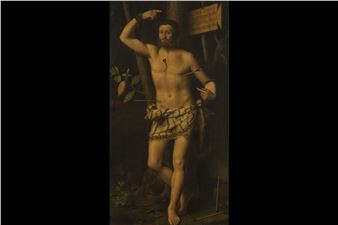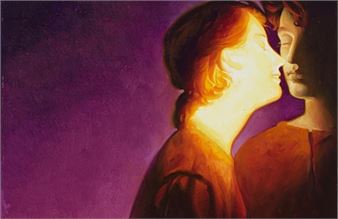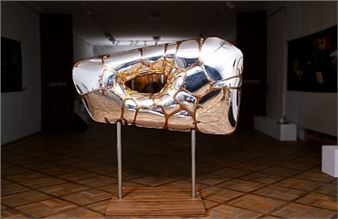Unrolled! Restoration of the Hermitage's Large-format Paintings
On January 25th, 2013, the Nicholas Hall hosted the opening of an exhibit entitled вҖңUnrolled! Restoration of the Hermitage's Large-format PaintingsвҖқ, where two portraits of the Orlov brothers from the brush of the Danish artist Vigilius Eriksen (1722-1782) and a canvass entitled вҖңThe Sacrament of PenanceвҖқ by the German artist Johann Friedrich Overbeck (1789-1869), restored in the State Hermitage MuseumвҖҷs laboratory for the scientific restoration of easel painting. These canvases, which have undergone full restoration, were presented to viewers for the first time in many years.
These paintings were stored in rolls for decades. This type of storage is generally used as a temporary, emergency measures, and is conditioned by a number of causes. One of them is the need to transport paintings that are several meters in height and width. Another cause is the lack of appropriate circumstances, and especially space for storing works of art in some other way. One way or another, as a result, these canvases turned out to be hidden not only from the public, but also from museum specialists.
In 2003, the Laboratory for the Scientific Restoration of Easel Painting received spacious facilities with contemporary restoration equipment in the new Restoration/Storage Centre complex in Staraya Derevnya. This made it possible for the restorers to begin an intensive, large scale program for unrolling the large paintings and preparing them for exhibition.
OverbeckвҖҷs painting вҖңThe Sacrament of PenanceвҖқ (1864) is a new version by the author of one of seven paintings on the subject of the seven sacraments. There were plans to weave tapestries on the same subject, similar to RaphaelвҖҷs famous rugs, but this was not done. At the same time, Count V.P. Orlov-Davydov ordered a painted monochromatic version of the card delivered to Russia in 1864 from the artist.
The portraitist Eriksen depicted Alexey Grigoryevich and Grigory Grigoryevich Orlov on a court carousel in 1766, the elder Orlov in the costume of a Roman and the younger - in the costume of a Saracen.
In 2010, the LaboratoryвҖҷs artist/restorers, S.N. Bogdanov, V.Y. Brovkin, P.A. Davydov, V.A. Korobov, M.V. Lapshin and A.S. Nikolsky began to work on EriksenвҖҷs paintings вҖңPortrait of A.G. Orlov in Turkish CostumeвҖқ and вҖңPortrait of G.G. Orlov in Roman CostumeвҖқ. The large-scale dress-up portraits (each of which is about 390 by 360 centimetres) were removed from their rolls for the first time since the 1960вҖҷs, and their condition was investigated.
After the portrait of Alexey Orlov was unrolled, severe deformations of its base were detected, along with signs of mildew on the posterior inset of the canvas, damages to the paint layer and the foundation, the marks of later restoration that largely intersected with the authorвҖҷs painting, changes in colour and tone. The painting needed a full set of restoration measures, which were taken immediately. After the reinforcement of the paint a 19th century insertion into the canvas with restoration marks was removed. The painting was transferred to a new canvass and placed on a new stretcher, the lacquer was thinned across the entire surface of the painting, and blackened marks were removed. During the unrolling process, a partially-preserved signature from the author was discovered, reading вҖңVigil....вҖқ The artist/restorer A.V. Ushakovsky developed an original system of preparing stretchers for large paintings for this particular painting, which made it possible to minimize the weight of the stretchers.
In addition to a full set of technical restoration measures, the portrait of Grigory Orlov needed a special painting restoration program, since 19th century restoration marks were detected during the unrolling of the painting. The painterвҖҷs design for the image of the head and mane of the horse, the red coat and plumage and other small details were changed drastically. The Hermitage restorers smoothed out an old layer of yellowed lacquer and removed later old marks, uncovering the artistвҖҷs original work.
OverbeckвҖҷs large work вҖңThe Sacrament of PenanceвҖқ was on a roll since the 1930s, which led to major deformation to the base, damage, cracking, abrasion to the paint layer, and grime. The restoration program for the painting included reinforcing the paint layer and foundation, correcting the deformation of the canvas, duplicating the restoration selvage and preparing a new stretcher. Many of the restoration measures and methods were unique. The special adhesive Lascaux was used by the Laboratory for the first time to prevent further formation to the thin original canvas. The distinguishing technical and technological features of this canvas made it necessary for the restorers to develop a method for reinforcing oil paintings.
In recent years, the Laboratory for the Scientific Restoration of Easel Painting at the State Hermitage Museum has fully restored works from various masters, schools and eras. Aside from the paintings presented in the Nicholas Hall, the permanent exposition in the portrait gallery of the Romanov house in the Winter Palace includes portraits of the Dutch queen Anna Pavlovna, N. Keyser and Alexandra Fyodorovna with children by G. Dawe which were unrolled and restored, and the Italian Majolica Hall hosts a painting by Garofalo, entitled вҖңAllegory of the Old and New TestamentsвҖқ. вҖңThe Storm of 1812вҖқ exhibit includes a newly restored painting by P. Hess, entitled вҖңThe Battle of Valutina GoraвҖқ. In the future, visitors to the museum and specialists will be able to see other works from the collection of the State Hermitage Museum, which included more than 80 rolled paintings.
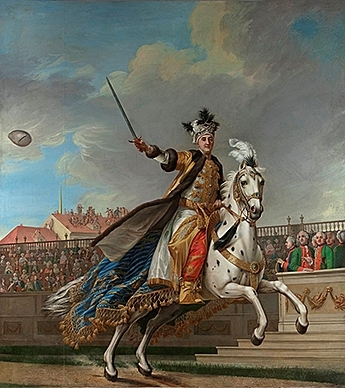
Recommended for you
On January 25th, 2013, the Nicholas Hall hosted the opening of an exhibit entitled вҖңUnrolled! Restoration of the Hermitage's Large-format PaintingsвҖқ, where two portraits of the Orlov brothers from the brush of the Danish artist Vigilius Eriksen (1722-1782) and a canvass entitled вҖңThe Sacrament of PenanceвҖқ by the German artist Johann Friedrich Overbeck (1789-1869), restored in the State Hermitage MuseumвҖҷs laboratory for the scientific restoration of easel painting. These canvases, which have undergone full restoration, were presented to viewers for the first time in many years.
These paintings were stored in rolls for decades. This type of storage is generally used as a temporary, emergency measures, and is conditioned by a number of causes. One of them is the need to transport paintings that are several meters in height and width. Another cause is the lack of appropriate circumstances, and especially space for storing works of art in some other way. One way or another, as a result, these canvases turned out to be hidden not only from the public, but also from museum specialists.
In 2003, the Laboratory for the Scientific Restoration of Easel Painting received spacious facilities with contemporary restoration equipment in the new Restoration/Storage Centre complex in Staraya Derevnya. This made it possible for the restorers to begin an intensive, large scale program for unrolling the large paintings and preparing them for exhibition.
OverbeckвҖҷs painting вҖңThe Sacrament of PenanceвҖқ (1864) is a new version by the author of one of seven paintings on the subject of the seven sacraments. There were plans to weave tapestries on the same subject, similar to RaphaelвҖҷs famous rugs, but this was not done. At the same time, Count V.P. Orlov-Davydov ordered a painted monochromatic version of the card delivered to Russia in 1864 from the artist.
The portraitist Eriksen depicted Alexey Grigoryevich and Grigory Grigoryevich Orlov on a court carousel in 1766, the elder Orlov in the costume of a Roman and the younger - in the costume of a Saracen.
In 2010, the LaboratoryвҖҷs artist/restorers, S.N. Bogdanov, V.Y. Brovkin, P.A. Davydov, V.A. Korobov, M.V. Lapshin and A.S. Nikolsky began to work on EriksenвҖҷs paintings вҖңPortrait of A.G. Orlov in Turkish CostumeвҖқ and вҖңPortrait of G.G. Orlov in Roman CostumeвҖқ. The large-scale dress-up portraits (each of which is about 390 by 360 centimetres) were removed from their rolls for the first time since the 1960вҖҷs, and their condition was investigated.
After the portrait of Alexey Orlov was unrolled, severe deformations of its base were detected, along with signs of mildew on the posterior inset of the canvas, damages to the paint layer and the foundation, the marks of later restoration that largely intersected with the authorвҖҷs painting, changes in colour and tone. The painting needed a full set of restoration measures, which were taken immediately. After the reinforcement of the paint a 19th century insertion into the canvas with restoration marks was removed. The painting was transferred to a new canvass and placed on a new stretcher, the lacquer was thinned across the entire surface of the painting, and blackened marks were removed. During the unrolling process, a partially-preserved signature from the author was discovered, reading вҖңVigil....вҖқ The artist/restorer A.V. Ushakovsky developed an original system of preparing stretchers for large paintings for this particular painting, which made it possible to minimize the weight of the stretchers.
In addition to a full set of technical restoration measures, the portrait of Grigory Orlov needed a special painting restoration program, since 19th century restoration marks were detected during the unrolling of the painting. The painterвҖҷs design for the image of the head and mane of the horse, the red coat and plumage and other small details were changed drastically. The Hermitage restorers smoothed out an old layer of yellowed lacquer and removed later old marks, uncovering the artistвҖҷs original work.
OverbeckвҖҷs large work вҖңThe Sacrament of PenanceвҖқ was on a roll since the 1930s, which led to major deformation to the base, damage, cracking, abrasion to the paint layer, and grime. The restoration program for the painting included reinforcing the paint layer and foundation, correcting the deformation of the canvas, duplicating the restoration selvage and preparing a new stretcher. Many of the restoration measures and methods were unique. The special adhesive Lascaux was used by the Laboratory for the first time to prevent further formation to the thin original canvas. The distinguishing technical and technological features of this canvas made it necessary for the restorers to develop a method for reinforcing oil paintings.
In recent years, the Laboratory for the Scientific Restoration of Easel Painting at the State Hermitage Museum has fully restored works from various masters, schools and eras. Aside from the paintings presented in the Nicholas Hall, the permanent exposition in the portrait gallery of the Romanov house in the Winter Palace includes portraits of the Dutch queen Anna Pavlovna, N. Keyser and Alexandra Fyodorovna with children by G. Dawe which were unrolled and restored, and the Italian Majolica Hall hosts a painting by Garofalo, entitled вҖңAllegory of the Old and New TestamentsвҖқ. вҖңThe Storm of 1812вҖқ exhibit includes a newly restored painting by P. Hess, entitled вҖңThe Battle of Valutina GoraвҖқ. In the future, visitors to the museum and specialists will be able to see other works from the collection of the State Hermitage Museum, which included more than 80 rolled paintings.
Artists on show
Contact details


 ARTISTS
ARTISTS








